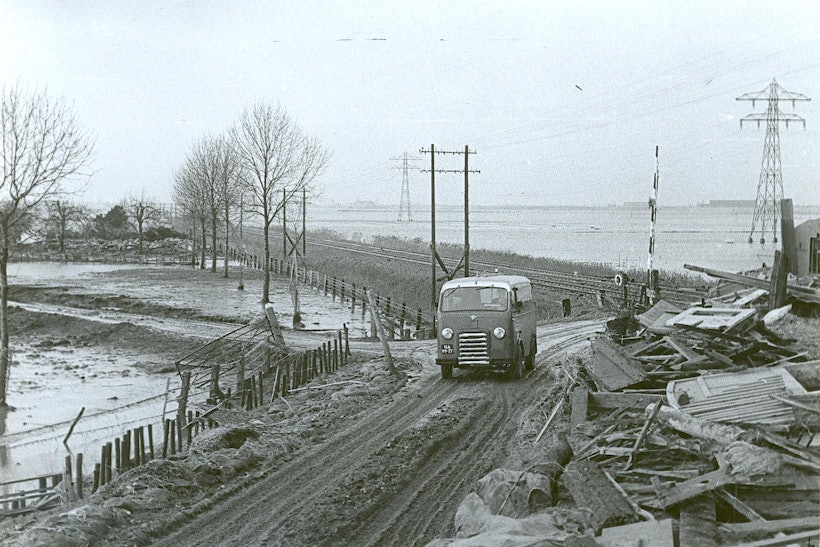The term ‘storm surge’ (‘stormvloed’) applies when the wind has pushed the water level far up above the mean sea level. In Zeeland the highest margin with regard to the mean sea level is approximately 1,5 meter above high tide. The largest flooding of the past centuries was the North Sea flowing of 1953.
Victims
During the flood an area of approximately 150.000 hectares of land in the provinces of Zeeland, Zuid-Holland and Noord-Brabant flooded. At the time, approximately 600.000 people lived in this area. In total 1836 people lost their lives, 865 people died in Zeeland, 677 in Zuid-Holland and 247 in Noord-Brabant and 7 people in Noord-Holland. 40 people died of later consequences. In 1953 the Red Cross published a list containing the names of all deceased individuals. This list shows how most victims lived in Schouwen-Duiveland.
Older statistics
At the start of 1954 the Red Cross published a book entitled ‘Complete list of casualties of the North Sea Flood 1953’, it contained the names of 1796 people. The records of this list are copied onto several websites. The numbers, however, can lead to some confusion.
The Red Cross only registered the victims who died during the flood. In the months following the flood, the Red Cross continuously published updated lists containing the names of the victims of the flood. On Tuesday the 8th of September 1953, the Red Cross published – they estimated this would be the final list – the 100th list containing the names of 1795 victims. At this moment their list still included 164 missing persons, of which 32 people were still recorded as missing yet their bodies had already been recovered. However, they could not be identified yet.
A different number of victims which is often mentioned is 1835. This number was recorded by the ‘Centraal Bureau voor de Statistiek’ (Statistics Netherlands) and published in the Statistisch Bulletin 1954 no. 8 of February 1st 1954. This number includes the amount of people who died after February 1st 1953 and whose cause of dead was recorded as ‘the hardships as consequences of the flood’ (“ontberingen tengevolge van de overstroming”). These persons were therefore only in hindsight through statistics included in the total amount of victims, in this case leading up to 1835. Their names have, as far as known, never been published.
Animals
Over 47.000 livestock animals and 140.000 poultry died in the water.
Those who were evacuated

Approximately 72.000 inhabitants from the south-western regions had to be evacuated for a prolonged amount of time. On May 1st 24.000 and later on October 1st an amount of 11.000 people had not returned to their homes (or what was left of them) yet.
The victims were brought to shelters for instance in Goes, Bergen op Zoom, Dordrecht and Rotterdam. Once they arrived, host families would take care of them. Some victims were able to find shelter in the areas surrounding their own home towns, which then allowed them to stay in touch with their own communities. Others, however, were evacuated to locations which were entirely ‘foreign’ to them.
Houses
Approximately 3.000 residential buildings and 300 farms were destroyed and over 400.000 residential buildings and 3.000 farms were damaged.
Land
Almost 200.000 hectares of land was flooded. The total amount costs regarding material damages was estimated to be over 1,5 billion guilders.
Storm surge
The term ‘storm surge’ (‘stormvloed’) applies when the wind has pushed the water level far up above the mean sea level. In Zeeland the highest margin with regard to the mean sea level is approximately 1,5 meter above high tide.
History
Ever since people settled down in the ‘low countries near the sea’ (“lage landen bij de zee”), they have been fighting the water. By constructing dikes, they gradually managed to reclaim some land. As a consequence the water was pushed back further and further, and new patches of land were created. The excess water was drained by drainage locks and later on by windmills.
The first ‘primitive’ dikes barely provided any protection from the sea. Flooding occurred regularly. From the nineteenth century onwards new techniques, materials, and machines were used to build stronger and higher dikes. However, even these improved dikes could not prevent flooding well into the twentieth century. During the flooding of March 12th 1906, tweny-five polders flooded in Zeeland. The storm of September 30th 1911 also left its marks on Zeeland during spring tide. And finally, the storm surge on January 13th 1916 damaged the Zuiderzee region severely. This event was the direct cause for the construction of the ‘Zuiderzee’ works.
Additional information

The 'Watersnoodmuseum' in Ouwerkerk (Schouwen-Duiveland).
www.watersnoodmuseum.nlThe 1835+1 project, a website commemorating the victims.
www.deramp.nlA webpage containing many additional links about the Flood
watersnood-1953.startkabel.nl
